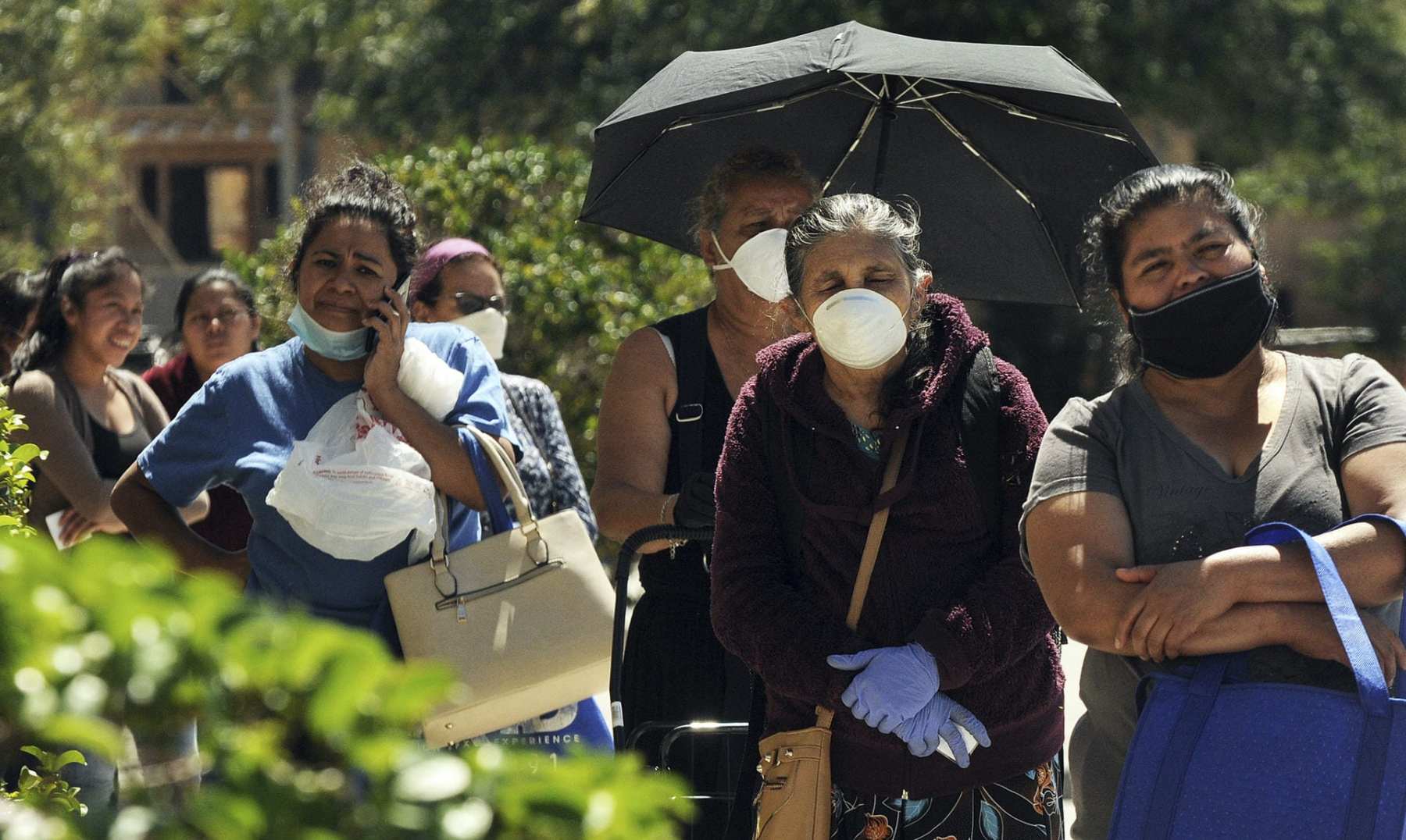This year women have endured an economic implosion so severe it triggered an unprecedented recession that has threatened to undo a decade of women’s progress in the labor force.
That’s why for many voters, America’s first female recession will be on the ballot.
Unemployment for women peaked at 15.5 percent this year as the jobs they dominated, in retail, hospitals and education, disappeared. Meanwhile, the already ailing child care industry was dealt a potentially fatal blow: One in five child care workers have lost their jobs and thousands of daycare centers have closed.
And many working mothers are considering leaving the labor force altogether, hamstrung by the persisting reality that, in heterosexual partnerships, they are performing an outsized share of the child care as many daycares and schools remain closed, while many male partners are in more financially stable positions.
From August to September alone, more women left their jobs — 865,000 — than the total number of jobs added to the U.S. labor market — 661,000.
Going into the 2020 election, voters cite the economy and the coronavirus outbreak as their top two concerns, and the two are intrinsically linked. Economists say the economy cannot rebound to its pre-pandemic levels of record low unemployment until the virus is under control.
That will put President Donald Trump’s record of handling the pandemic thus far into question, particularly following the revelation that the president himself has contracted the virus following his reluctance to follow medical guidelines.
It’ll also put added scrutiny on his and former Vice President Joe Biden’s plans for the recovery, and how they’ll handle the inequalities that have grown deeper this year for women thanks to uneven access to child care, paid leave and a persisting gender pay gap.
“The crisis has really made it very clear to everybody what this means and how big these inequalities are,” said Matthias Doepke, an economist at Northwestern who co-authored a study on the impact of the pandemic recession on women. “And it’s not just necessarily for those who are directly affected — but for the whole country.”
The pandemic and the recovery
Earlier in the year, Democrats and Republicans moved quickly to address the nosedive in the economy brought by the virus.
How has the pandemic recession been handled so far?
Trump signed into law the Families First Coronavirus Response Act (FFCRA) and the Coronavirus Aid, Relief and Economic Security Act, or the CARES Act, which focused on additional payments of unemployment insurance and benefits for workers, as well as the passage of the Paycheck Protection Program, offering PPP loans to small businesses.
But in the haste to administer the programs, their benefits were applied unevenly and unequally. The $1,200 stimulus checks sent through the CARES Act inadvertently went to more than a million dead people and the majority of female-owned businesses and businesses held by people of color were shut out of getting PPP funds.
What benefits came out of the FFCRA, the CARES Act and PPP?
The CARES Act and the FFCRA offered $600 weekly federal unemployment insurance payments to workers who were laid off or furloughed, on top of state-level benefits. Those payments expired July 31.
The bills also provided two weeks of paid sick time for the rest of the year to workers at small- and medium-sized companies. Only 20 percent of U.S. workers are covered by that provision.
For small businesses, low-interest PPP loans could be used to cover expenses such as payroll and rent, and can be partially or fully forgiven as long as companies retain their employees. But most of those went to companies that had existing banking relationships, shutting out many minority-owned businesses.
Since, conversations about another round of stimulus have repeatedly halted and restarted. Trump has pushed for more unemployment insurance to households after the federal $600 a week benefit expired at the end of the summer, but at a lower rate of $300 a week.
House Speaker Nancy Pelosi and Treasury Secretary Steven Mnuchin recently restarted negotiations of a scaled back version of the $2.2 trillion stimulus bill that the House passed in the summer but Republicans rejected saying it was too costly. Mnuchin said last week that the president was supportive of making a deal, including one that’s higher than the White House’s initial request for a $1 trillion stimulus.
But those talks fell apart again. Trump tweeted October 6 that the figure Democrats were seeking was still too high and said he was rejecting another round of stimulus — for now.
Instead, Trump said he has instructed his “representatives to stop negotiating until after the election when, immediately after I win, we will pass a major Stimulus Bill that focuses on hardworking Americans and Small Business.”
What do economists say about the candidates’ recovery plans?
Trump’s further plans for a recovery remain unclear. He has not laid out a specific platform, but has instead highlighted the booming economy that he presided over prior to the pandemic, some of which he inherited from the Obama administration.
“We are doing record business,” Trump said at the first presidential debate with Biden, while unemployment continued to hover at 7.9 percent, a figure not seen since 2012. Only about half of all jobs have returned.
A recent analysis of both Trump’s and Biden’s platforms by independent economists at Moody’s Analytics found that the biggest economic rebound would occur if Biden won the presidency and Democrats took over the Republican-controlled Senate.
From August to September 865,000 women left the workforce.
The scenario, while unlikely, assumes that all of Biden’s economic policies pass, resulting in a faster economic rebound than forecast if Trump were to win the White House and Republicans took control of the Democrat-controlled House. Under a Biden administration, a rebound is forecast for the second half of 2022, compared to the first half of 2024 under Trump.
According to Moody’s analysis, Biden’s plans would translate to higher GDP and 7.4 million more jobs than under Trump.
But it’ll come at a price: Government spending in infrastructure, education and social safety net programs would increase the budget deficit by $2 trillion in Biden’s first term, while Trump’s plans would add $250 billion. But the greater debt under Biden would be offset by low interest rates and a quicker rebound, Moody’s found.
In the long-term, both candidates’ policies add a similar amount to the nation’s deficits.
How will women be impacted?
Of all the jobs lost this year to coronavirus, about 60 percent of those losses went to women, and though those lost jobs are starting to return, not everyone is benefiting equally.
White women, for example, have recovered about 60 percent of all the jobs lost because of COVID-19, but Black women have only recovered 39 percent, the slowest rate of gains.
That impacts the way that different groups will look at the recovery.
Of the 40 lowest-paid jobs, women make up two-thirds of that workforce.
Trump’s plans will focus on making permanent the tax cuts he implemented in 2017, which are set to expire in 2026.
The 2017 law gave the biggest breaks to White households making more than $110,000. A 2018 report by the Institute on Taxation and Economic Policy, a liberal think tank, and the nonprofit Prosperity Now, found that those households took in $200 billion of the overall $275 billion in the package.
What was Trump’s tax reform plan?
The Tax Cuts and Jobs Act was signed into law in December 2017, representing a historic tax overhaul.
The corporate tax rate dropped from 35 percent to 21 percent — the biggest one-time cut for large companies in the nation’s history. For the highest earners, it lowered the top interest rate from 39.6 percent to 37 percent and changed the highest threshold from households with married couples earning $470,700 to those earning $600,000 or more.
It also lowered the tax rate for earners at all income levels, and increased the number of people who will pay no taxes to nearly 48 percent of Americans from 44 percent when the law was passed. The majority of the law’s benefits were aimed at businesses.
Biden’s economic plan is more likely to benefit low- and middle-income earners, which will particularly impact women, who make up two-thirds of the workforce in the 40 lowest paid jobs. People earning more than $400,000 will pay more in taxes, with the top income tax rate going back to 39.6 percent as it was prior to Trump’s 2017 law. The corporate tax rate would rise from 21 percent to 28 percent.
Biden’s economic platform, which consists of more than 45 proposals, outlines policies aimed at lessening the disparities women face.
Among them: Raising the federal minimum wage to $15 an hour and eliminating the subminimum tipped wage, and requiring public companies to report the gender and racial makeup of their boards.
Biden also wants to work to close the gender pay gap by passing the Paycheck Fairness Act, which among several provisions would require employers to prove pay disparities exist for legitimate reasons, bolster protections for workers who discuss salary history and give the Department of Labor more tools to pursue cases of wage disparity.
What is the gender pay gap?
The gender pay gap refers to the difference in the median earnings for all men and women regardless of the type of job or seniority. It’s considered a “raw” figure, but is indicative of occupational segregation that keeps women in lower-paid jobs and in fewer senior-level positions.
In 2020, the gender pay gap for women compared to White men was 82 cents. It was wider for women of color: Latinas make 54 cents on the White male dollar, for Black women it is 62 cents and for Native American women it is 57 cents. The gender pay gap has been a consistent issue in the White House.
During the Obama administration female staffers were paid between 84 and 89 cents for every $1 paid to male staffers. During the Trump administration, the gap has widened. In 2020, women were paid 69 cents for every $1 male staffers earned, a reflection of the concentration of women in lower-paid positions and more men in the top leadership jobs.
How have past recessions affected elections?
Research shows that economic crises can hit incumbent candidates and their parties. Presidents Herbert Hoover, Jimmy Carter and George H. W. Bush all lost elections following economic slowdowns, and Republicans failed in 2008 in part due to the fallout of the Great Recession, said Jake Haselswerdt, assistant professor in the department of political science at the University of Missouri.
But “as the public gets more polarized, that probably matters less,” Haselswerdt said. It’s unclear how the unique combination of a recession and a public health crisis will play out in November.
There’s also the question of how economic downturns affect individuals. Haselswerdt’s research found that economic disruptions can depress voter participation for the people most directly impacted, typically low-income earners.
Latinas have the highest gender pay gap, earning 54 cents on the White male dollar.
“People have limited energy and intention,” Haselswerdt said, “and when your life is disrupted you’re paying attention to your first order needs.”
But there is also evidence this year will be an anomaly. Early voting has been robust in several states where ballots are already being cast.
Doepke, the Northwestern economist, said he expects the outsized impact on women this year to be a driving force.
“It’s really for many families the number one thing really affecting them during this crisis,” he said. “Some have gotten sick, but almost every family has been affected by the employment impact, so I do think it’s front and center for many.”
Child care and paid leave
The other part of the economic equation for many families and women, in particular, this year will be any changes to the child care system.
How will the candidates address the child care crisis?
During his presidency, Trump passed an increase to the child tax credit as part of his 2017 tax overhaul. The tax credit doubled from $1,000 per child to $2,000 per child for families making up to about $400,000. More of the tax credit also became refundable, so that low-income families got up to $1,400 back, instead of about $1,100.
The achievement is one that Ivanka Trump pushed as part of her plan to help working mothers. Ivanka has spoken about getting more bipartisan support to address the severe challenges in the industry, which subsists on razor thin margins but charges rates that make child care inaccessible for many working families.
The pandemic now threatens to undo the industry altogether. But the Trump campaign has not said much on the subject, omitting any discussion of the current crisis during the Republican National Convention when Ivanka spoke specifically on the president’s record with women.
In general, Republicans have been opposed to child care policies paid through tax hikes, supporting instead policies like a bipartisan bill that essentially allows new parents to borrow from their future selves and collect their future tax credits early in exchange for a smaller credit later.
Biden, who cared for his two sons as a single father after the death of his wife and daughter in 1972, has laid out a 10-year, $325 billion child care proposal as part of his campaign.
It would offer free pre-kindergarten to 3- and 4-year-olds, as well as tax credits to low-income families to reduce the cost of child care or sliding scale subsidies that would cap low-income families at spending no more than 7 percent of their earnings on child care. The plan also increases pay for child care instructors — a field that is 95 percent female — to put them on par with similarly qualified kindergarten teachers.
The other part of Biden’s plan addresses elder care, earmarking $450 billion to eliminate the 800,000-person waiting list for home and community care under Medicaid, and expanding home and community-based alternatives for care. Combined, the child and elder care proposals would add 3 million jobs.
What is being proposed for paid family and sick leave?
Under Biden’s plan, workers would be guaranteed 12 weeks of paid family and medical leave. Research shows the lack of such policies has stalled women’s participation in the workforce.
Women’s participation in the labor force peaked in the late 1990s and has leveled off since in the United States, while continuing to grow in other countries. A possible explanation, Doepke said, is that other nations, particularly in Europe, have enacted universal family leave policies and offer government-subsidized child care.
Moody’s found that Biden’s policies around paid leave and elder care alone would increase labor force participation, resulting in a participation rate that is a percentage point higher a decade from now.
Trump has also said he supports family leave, mentioning it in each of his State of the Union addresses — the first Republican president to do so — but it’s unclear how he plans to tackle the issue during a second term. In 2019, the president passed 12 weeks of paid parental leave for federal employees.
As the country gets closer to Election Day, both candidates will likely have to discuss these issues in more detail if they hope to win over some undecided female voters. It’ll be crucial for Republicans in particular. Trump continues to trail Biden with female voters by double digits.






